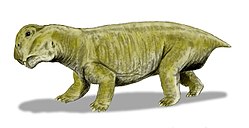Skull
The skull of Emydops is small, up to 5 cm (2 in) long.
The premaxillae and maxillae of Emydops are less pronounced than those of more mature dicynodonts, and they are generated downward as a distinct outer rim that is most developed around the canines. Anteriorly, the rim continues slightly downwards and forms the tip of the upper beak. [6] The orbits are positioned far anteriorly in the skull, and face forward and upward. [1] The temporal region is large in proportion to the face and provides attachment for the laterodorsal trigeminal musculature of enormous bulk. In dorsal view, the temporal vacuities are described to be large and the ventrolateral region of the cheek is deeply excavated. [6]
Convergently evolved from cynodonts, dicynodonts also have a secondary palate which consists of a broad, flat, horizontal plate formed anteriorly by the palatines. Additionally, it extends posteriorly by the palatines, which dip gently downward to the rear. [6]
The reflected lamina of the angular bone of Emydops is large and fan-shaped, like other small dicynodonts. However, unlike many dicynodonts, the reflected lamina of the angular bone of Emydops has a broad, thin, unsupported sheet that terminates in a long, free border rather than the sheet folding and converging anteriorly toward a marginal thickening on the angular body. [6] As well, a broadened lateral dentary shelf on the lower jaw serves as another distinguishing feature of the genus. [1]
Dentition
Most skulls of Emydops bear a pair of caniniform tusks, diagnostic of dicynodonts, There are generally three postcanine teeth present in the upper jaw of Emydops. They are arranged in a straight line parallel to the mandibular teeth. As seen in cross-section, the crowns of the maxillary postcanine teeth are unserrated and round to slightly widened. [6] In contrast, the mandible of Emydops consists of seven functional teeth, in which the crowns are described as pear-shaped: they have wide, blunt anterior edges and sharp, strongly serrated posterior edges. [6]
The holotype specimen of E. oweni is unusual in that it has two pairs of tusks. The second pair of tusks is not seen in any other dicynodont, and is a feature unique to the specimen. The extra tusks are considered a pathological feature; they are thought to have been the result of a mutation in the individual and are not considered a defining characteristic of the species. [2]







